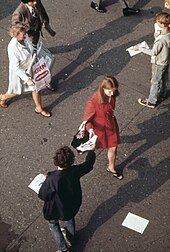This article includes alist of references,related reading,orexternal links,but its sources remain unclear because it lacksinline citations.(August 2011) |
Aflyer(orflier) is a form ofpaperadvertisementintended for wide distribution and typically posted or distributed in a public place, handed out to individuals or sent through the mail. Today, flyers range from inexpensivelyphotocopiedleaflets to expensive, glossy, full-color circulars. Flyers in a digital format can be shared on the internet.

Terminology
editA flyer is also called a "palm card",[1]"circular", "handbill", "pamphlet","poster","lit' "(literature)," weekly ad "," catalogue "or" leaflet ".[citation needed]
Usage
editFlyers may be used by individuals,businesses,not-for-profit organizations or governments to:
- Advertise an event such as a musicconcert,nightclubappearance,festival,or politicalrally
- Promote agoods-selling businesses such as aused carlotdiscount storeor aservicebusiness such as arestaurantormassage parlour.
- Persuade people about a social, religious, or political message, as inevangelismorpolitical campaignactivities on behalf of apolitical partyor candidate during an election. Flyers have been used in armed conflict: for example,airborne leaflet propagandahas been a tactic ofpsychological warfare.
- Recruit members for organizations or companies.
Likepostcards,pamphletsand smallposters,flyers are a low-cost form ofmass marketingorcommunication.There are many different flyer formats. Some examples include:
- A4(roughlyletterheadsize)
- A5 (roughly half letterhead size)
- DL (compliments slipsize)
- A6 (postcardsize)
Flyers are inexpensive to produce and they required only a basicprinting pressfrom the 18th century to the 20th century. Their widespread use intensified in the 1990s with the spread of less expensivedesktop publishingsystems. In the 2010s, inexpensive black and white flyers can be produced with just apersonal computerand acomputer printer.In the 2010s, the ordering of flyers through traditional printing services has been supplanted byInternetservices. Customers send designs, review proofs online or via e-mail and receive the final products by mail.
Flyers are not a new medium: prior to theWar of American Independencesome colonists were outraged with theStamp Act (1765)and gathered together in anti-stamp act congresses and meetings. In these congresses they had to win support, and issued handbills and leaflets, pamphlets, along with other written paraphernalia, to do so.
In the 2000s, some jurisdictions have laws orordinancesbanning or restricting leafleting or flyering in certain locations. Owners of private property may put up signs saying "Post No Bills";this occurs particularly on wooden fences surrounding building sites or vacant lots.
Distribution and use
editFlyers are handed out inpublic spaceor atevents(a practice known as "flyering" or "leafleting" ), distributed door-to-door, sent through themail,put under windshield wipers of cars, or afixed tobulletin boards,utility poles,walls, or other surfaces.
Cheap to produce, contemporary flyers are frequently produced in 300g/m2glossy card, whereas a leaflet might be produced on a 130 g/m2–170 g/m2weight paper and can be a very effective form ofdirect marketing.
Some individuals and organizations send flyers throughe-mail,a tactic that avoids spending money on paper, printing and mailing or hiring people to post the flyers on telephone poles or hand them out. Digital flyers can be shared on the internet. The digital flyer may be embedded into the body of the e-mail or added as an attachment to be opened.
-
Distribution of leafletsoverAfghanistanby the U.S. military in 2010
-
Common Sensewas a pamphlet that was distributed preceding the American Revolution
See also
editReferences
edit- ^Art (October 20, 2020)."Palm Reading".history.house.gov.US House of Representatives:History, Art & Archives.Retrieved22 April2023.
- Ackland-Snow, Nicola & Brett, Nathan & Williams, Steven.Fly: The Art of the Club Flyer.Watson-Guptill Publications, 1997.ISBN0-8230-1854-7
- Searching for the Perfect Beat: Flyer Designs of the American Rave Scene.Watson-Guptill, 2000. by The Earth Program (Author), Neil Strauss (Introduction).ISBN0-8230-4751-2
- Barcelona Club Flyers (Actar Publishing, 1999), by Tite Barbuzza (Contributor), Joan Manel Jubany (Contributor), Albert Masferrer (Contributor), Yolanda Muelas (Contributor),ISBN84-89698-25-2
- Büru Destruct (Consortium Book Sales & Dist, 1999), By Büru Destruct,ISBN3-931126-24-2
- Clubspotting (Happy Books, 2000), by Paolo Davoli & Gabriele Fantuzzi,ISBN88-86416-24-5
- Design After Dark: The Story of Dancefloor Style (Thames and Hudson, London, 1991), by Cynthia Rose,ISBN0-500-27648-X
- Design Agent 007: License to Design DGV.Die gestaften Verlag, Berlin 2002.ISBN3-931126-14-5
- Event Flyer Graphics.Nippan/Biblios, 2001.ISBN3-910052-75-4
- Flyer Soziotope: Topography of a Media Phenomenon.(Archiv der Jugendkulturen (G)/Actar (ES), 2005), German-English and English-German.ISBN3-86546-032-1,ISBN84-96540-03-0
- Klanten, Robert & Peyerl, Andreas & Hollmann-Loges, Markus:Flyermania: European Flyers.Art Books Intl Ltd, 1998.ISBN3-931126-15-3
- Highflyers: Clubravepartyart.By 3 Beat Music. Booth Clibborn Editions, London, UK, 1995.ISBN1-873968-78-7
- Beddard, Phil:Nocturnal: Global Highflyers.Booth-Clibborn, 2000.ISBN1-86154-169-4
- Jordan, Joel T. et alii:Searching for the Perfect Beat: Flyer Designs of the American Rave Scene.Watson-Guptill Pubns, US, 2000.ISBN0-8230-4751-2
External links
edit- Media related toHand billsat Wikimedia Commons